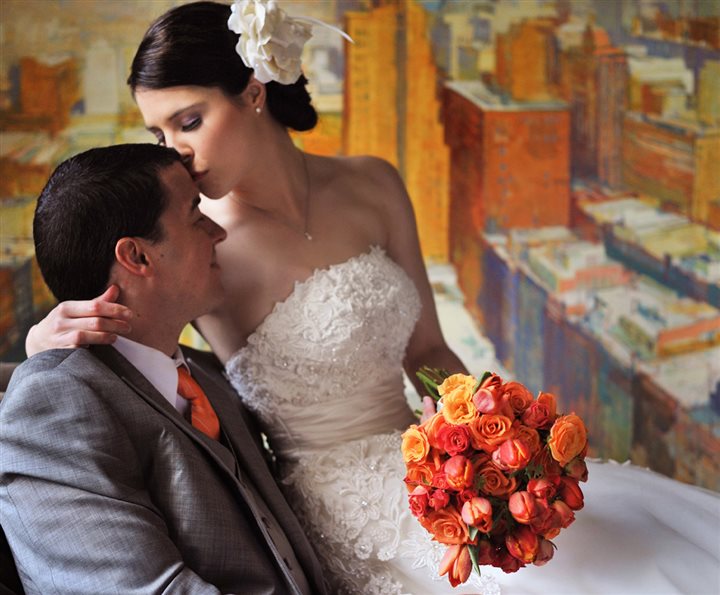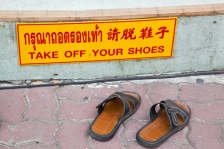 (BPT) – Some moments are simply too important to trust to a camera phone.
(BPT) – Some moments are simply too important to trust to a camera phone.
Your wedding will be one of the most memorable times of your life and no one can capture it better than a professional photographer. So how do you find the right one? As you begin the interview process, here are 10 questions to help you determine if you’ve found the best photographer for your wedding.
1. Does the photographer have a gallery of wedding images you can review?
Reviewing sample work allows you to see the photographer’s strengths and weaknesses – don’t fool yourself, every photographer has them. You’ll also be able to get an idea of their style. Are they formal with an eye for the perfect picture or do they love to capture the hidden moments when no one is looking? Look for images that you can see yourself in. Think of three words that describe you and share those with your photographer. Every photographer has a style and reviewing their gallery can help you determine if theirs is right for you.
2. What is the photographer’s working style?
Some photographers are orderly and operate like wedding planners. Others prefer to sit back and let the events of the wedding unfold. It’s important that you find someone who can understand and meet your expectations. Discuss this ahead of time and ask away, so that you understand how well the photographer’s working style matches your own.
3. Is the photographer available for an engagement session?
An engagement session does more than provide you with priceless images together before you get married. It’s also your first opportunity to work with your photographer and develop a relationship that will allow you to be completely at ease on your big day. Use this session to confirm if the photographer is indeed the right person to capture your wedding.
4. Will the photographer create a detailed shot list?
This list will ensure no important photo is missed during the commotion and excitement of the big day. You should be able to create that list together, add to the list leading up to the day and have a copy of that list the day of. Take an honest look at what images really matter and fill your photographer in on situations he or she might need to be aware of in order to prevent awkward moments, and to ensure that he or she can get the shots that matter most.
5. What kind of lighting will be used?
Whether you have an indoor or outdoor wedding, you’ll want to make sure your photographer has professional grade lighting equipment to deliver the images your wedding deserves.
6. Does the photographer have backup equipment?
You’ve prepared contingency plans for every other aspect of your wedding; your photographer should as well. A true professional photographer won’t miss your perfect shot because of a technology issue. He or she will always bring one or two backup cameras, lenses, flashes, additional lighting equipment, extra memory cards, and batteries.
7. Does the photographer have liability insurance?
Accidents happen at weddings and if one of your guests trips over your photographer’s light stand, it’s good to know you both are protected. Your reception venue may even ask the photographer to submit a certificate of liability ahead of time.
8. Will there be one photographer or two?
A second shooter increases the probability that no shot will be missed, especially if you are having a large wedding. If there will be two photographers, ask to meet them both to get a feel for their personalities and how well they might blend in on your big day.
9. What will happen to the images after your wedding?
Will your images be backed up to a hard drive or the cloud once processed? How long will your photographer keep the images afterward? Will they be kept for a couple of years or dumped immediately? If you have any concerns about losing your photos, knowing what the photographer plans to do with your images after your wedding is important.
10. When will you get your photos?
No, you won’t get your pictures the day after; no photographer can deliver that quickly. It’s a good idea, though, to get a general idea of the timeline ahead of time. You might even be able to agree on getting a couple of images ready for social media use very quickly. But obtaining your photos will likely take several weeks. To help with the wait, some photographers will send you a sneak peak with a few images. Just ask ahead of time!
You won’t be able to see everything that happens during your wedding day. The right photographer will capture moments you never knew existed. To learn how you can find the perfect photographer for your wedding, visit ppa.com/weddingphotographer.

 Be careful this time of year, as April Fool’s Day is right around the corner. Also known worldwide as All Fools Day, this day has been celebrated for centuries in countries like the U.S., Canada, Europe, Australia and Brazil. If you aren’t careful on April 1, this popular day could make you a “victim” of a light-hearted practical joke or hoax. While our behavior is all fun and games at home, you’ll want to be sure you aren’t fooled into thinking the following behavior is okay when you travel abroad:
Be careful this time of year, as April Fool’s Day is right around the corner. Also known worldwide as All Fools Day, this day has been celebrated for centuries in countries like the U.S., Canada, Europe, Australia and Brazil. If you aren’t careful on April 1, this popular day could make you a “victim” of a light-hearted practical joke or hoax. While our behavior is all fun and games at home, you’ll want to be sure you aren’t fooled into thinking the following behavior is okay when you travel abroad:
- Talking Over Dinner
In America, talking over dinner is commonplace – in fact, more and more experts are encouraging it. But if you travel to China, Japan and some places in Africa talking over food is a major no-no. In these countries, the food is the star. Those who chat over dinner will likely be met with silence – dinner is meant for eating, not talking.1
Be aware that talking in places that some countries consider sacred is also off limits – churches in Europe, temples in Thailand, and saunas in Finland.
- Patting Someone’s Head
We see it all the time in America – adults patting kids on the head. Sometimes an adult pats another adult on the head. But those who do this in Buddhist countries, do so at their own risk. That’s because the head is considered the seat of the soul and touching the top of it is highly insulting, even for a child.2
Another thing that’s not okay to do in other countries? Pointing with a finger. This gesture is considered rude in Malaysia (instead they point with a closed fist, the thumb at the top indicating direction). Filipinos are even more low-key, singling out an object by shifting their eyes towards it or pursing their lips and pointing with their mouth.2
- Wearing Shoes Inside
If you plan to visit Japan, remember to remove your shoes upon entering someone’s home or entering a temple. Once your shoes are removed, you’ll likely be given slippers to take you from front door to living room, but after that, the slippers should be removed before you step on the tatami (reed mat).1
- Eating with Your Left Hand
Don’t greet a person or eat with your left hand in Hindu and Muslim countries. Why is this so offensive? Well,while eating and greeting is the duty of your right hand, the left hand takes care of all of the other “duties” – it is therefore considered unclean.1
- Looking Others in the Eye
If you live in America, chances are you think that those who do not make direct eye contact are rude, weak or indifferent. However, holding a long gaze in some Asian nations is considered rude and makes other uncomfortable.
Rules differ all over the world, however, because if you are in Germany and raising a toast to friends, your eyes better meet theirs!
Sources:
1 http://www.travelandleisure.com/slideshows/worlds-worst-cultural-mistakes
2 http://www.theguardian.com/travel/2007/oct/15/top10.culturaltrips
|
We plan many different types of trips including cruising. One of the best parts of cruising is exploring the various ports of call. Booking excursions can enhance your trip while giving you insight to other cultures. Ask our agents how to view tours for your next cruise. If you don’t have a cruise booked, call our office today at 636-625-8747!
|
|
|
|
Cozumel, Mexico

Cozumel is a small island off the mainland but a short ferry ride to Playa del Carmen. There are beach clubs if you want to relax and enjoy the sand for a few hours. Chankanaab Park offers the chance to snorkel or swim with dolphins. Scuba divers will find one of the best reefs here. There are many shops and restaurants right off port that are walking distance. You can book tours to ruins and other attractions on the mainland. I would suggest booking with the cruiseline to avoid issues returning to the ship on time. Internet tip: Senor Frogs has wifi for customers. Also I am told they have the BEST guacamole.
|
|
Jamaica

Currently there are three fun ports in Jamaica. They each offer some specials sights and tours for everyone whether you want beach time or adventure like Dunn River Falls. Falmouth is a newer port with shops, a Craft Market and restaurants like Margaritaville and Nathan’s Hot Dogs. One tour highly recommended for couples wanting to relax is river rafting down Martha Brae. Mystic Mountain has the famous Jamaica Bobsled ride and ziplining located in Ocho Rios for those wanting more excitement. The culture in Jamaica and friendliness of the people are most important so take a tour to experience this small but unique country. Internet tip: Falmouth offers daily internet packages.
|
|
Grand Cayman

This is a common stop for Western sailings. Although famous for the 7 mile beach you also can visit Stingray City and stroll through shops downtown. I recommend taking the kids to the Turtle Farm. It was very cool! This is a very clean and safe island so be sure to take a tour to explore area. Georgetown is a world-famous centre for off-shore banking and investments. You won’t see the same poverty as other islands. Internet tip: Margaritaville offers free wifi for customers.
|
|
|
Travel is fun so be sure to get the most our of your trip. Our experienced travel agents do more than book vacations. We can offer insight for prenight hotels, transportation options and excursions. Many extras that can enhance your trip.
|
|
 Be careful this time of year, as April Fool’s Day is right around the corner. Also known worldwide as All Fools Day, this day has been celebrated for centuries in countries like the U.S., Canada, Europe, Australia and Brazil. If you aren’t careful on April 1, this popular day could make you a “victim” of a light-hearted practical joke or hoax. While our behavior is all fun and games at home, you’ll want to be sure you aren’t fooled into thinking the following behavior is okay when you travel abroad:
Be careful this time of year, as April Fool’s Day is right around the corner. Also known worldwide as All Fools Day, this day has been celebrated for centuries in countries like the U.S., Canada, Europe, Australia and Brazil. If you aren’t careful on April 1, this popular day could make you a “victim” of a light-hearted practical joke or hoax. While our behavior is all fun and games at home, you’ll want to be sure you aren’t fooled into thinking the following behavior is okay when you travel abroad:
 (BPT) – Some moments are simply too important to trust to a camera phone.
(BPT) – Some moments are simply too important to trust to a camera phone.






